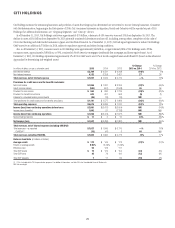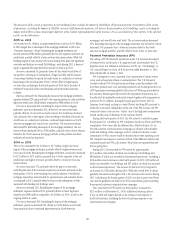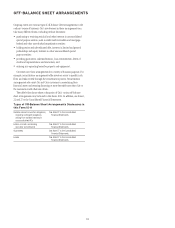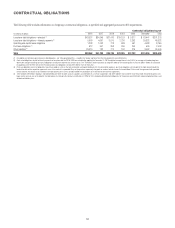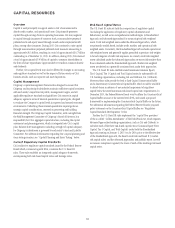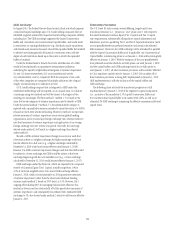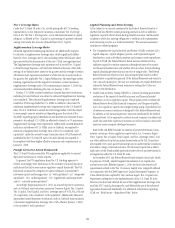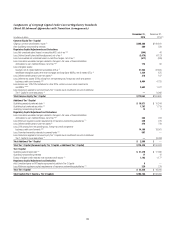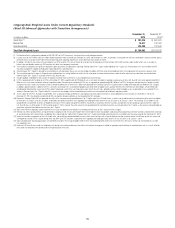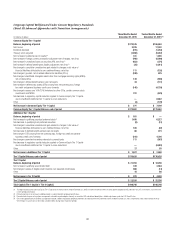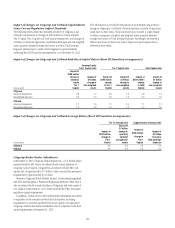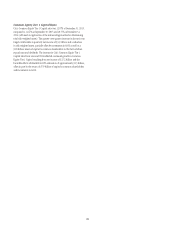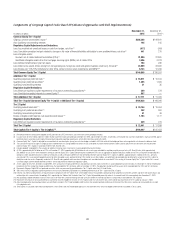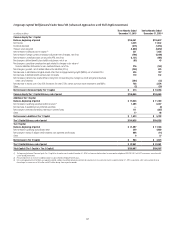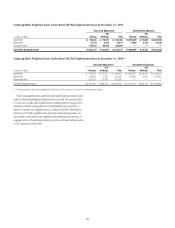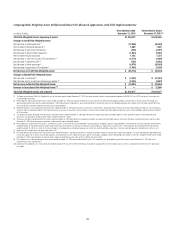Citibank 2015 Annual Report Download - page 57
Download and view the complete annual report
Please find page 57 of the 2015 Citibank annual report below. You can navigate through the pages in the report by either clicking on the pages listed below, or by using the keyword search tool below to find specific information within the annual report.
39
Citigroup Risk-Weighted Assets Under Current Regulatory Standards
(Basel III Advanced Approaches with Transition Arrangements)
In millions of dollars
December 31,
2015
December 31,
2014 (1)
Credit Risk (15) $ 791,036 $ 861,691
Market Risk 74,817 100,481
Operational Risk 325,000 312,500
Total Risk-Weighted Assets $1,190,853 $1,274,672
(1) Restated to reflect the retrospective adoption of ASU 2014-01 for LIHTC investments, consistent with current period presentation.
(2) Issuance costs of $147 million and $124 million related to preferred stock outstanding at December 31, 2015 and December 31, 2014, respectively, are excluded from common stockholders’ equity and netted against
preferred stock in accordance with Federal Reserve Board regulatory reporting requirements, which differ from those under U.S. GAAP.
(3) In addition, includes the net amount of unamortized loss on HTM securities. This amount relates to securities that were previously transferred from AFS to HTM, and non-credit related factors such as changes in
interest rates and liquidity spreads for HTM securities with other-than-temporary impairment.
(4) The transition arrangements for significant regulatory capital adjustments and deductions impacting Common Equity Tier 1 Capital and/or Additional Tier 1 Capital are set forth above in the chart entitled “Basel III
Transition Arrangements: Significant Regulatory Capital Adjustments and Deductions.”
(5) Common Equity Tier 1 Capital is adjusted for accumulated net unrealized gains (losses) on cash flow hedges included in AOCI that relate to the hedging of items not recognized at fair value on the balance sheet.
(6) The cumulative impact of changes in Citigroup’s own creditworthiness in valuing liabilities for which the fair value option has been elected and own-credit valuation adjustments on derivatives are excluded from
Common Equity Tier 1 Capital, in accordance with the U.S. Basel III rules.
(7) Includes goodwill “embedded” in the valuation of significant common stock investments in unconsolidated financial institutions.
(8) Of Citi’s approximately $47.8 billion of net DTAs at December 31, 2015, approximately $22.9 billion of such assets were includable in regulatory capital pursuant to the U.S. Basel III rules, while approximately $24.9
billion of such assets were excluded in arriving at regulatory capital. Comprising the excluded net DTAs was an aggregate of approximately $26.3 billion of net DTAs arising from net operating loss, foreign tax credit
and general business credit carry-forwards as well as temporary differences, of which $12.1 billion were deducted from Common Equity Tier 1 Capital and $14.2 billion were deducted from Additional Tier 1 Capital.
In addition, approximately $1.4 billion of net DTLs, primarily consisting of DTLs associated with goodwill and certain other intangible assets, partially offset by DTAs related to cash flow hedges, are permitted to be
excluded prior to deriving the amount of net DTAs subject to deduction under these rules. Separately, under the U.S. Basel III rules, goodwill and these other intangible assets are deducted net of associated DTLs in
arriving at Common Equity Tier 1 Capital, while Citi’s current cash flow hedges and the related deferred tax effects are not required to be reflected in regulatory capital.
(9) Assets subject to 10%/15% limitations include MSRs, DTAs arising from temporary differences and significant common stock investments in unconsolidated financial institutions. At December 31, 2015 and
December 31, 2014, the deduction related only to DTAs arising from temporary differences that exceeded the 10% limitation.
(10) Represents Citigroup Capital XIII trust preferred securities, which are permanently grandfathered as Tier 1 Capital under the U.S. Basel III rules, as well as non-grandfathered trust preferred securities which are eligible
for inclusion in an amount up to 25% and 50%, respectively, during 2015 and 2014, of the aggregate outstanding principal amounts of such issuances as of January 1, 2014. The remaining 75% and 50% of non-
grandfathered trust preferred securities are eligible for inclusion in Tier 2 Capital during 2015 and 2014, respectively, in accordance with the transition arrangements for non-qualifying capital instruments under the
U.S. Basel III rules. As of December 31, 2015 and December 31, 2014, however, the entire amount of non-grandfathered trust preferred securities was included within Tier 1 Capital, as the amounts outstanding did not
exceed the respective threshold for exclusion from Tier 1 Capital.
(11) 50% of the minimum regulatory capital requirements of insurance underwriting subsidiaries must be deducted from each of Tier 1 Capital and Tier 2 Capital.
(12) Effective July 2015, banking entities are required to be in compliance with the so-called “Volcker Rule” of the Dodd-Frank Act that prohibits conducting certain proprietary investment activities and limits their ownership
of, and relationships with, covered funds. Accordingly, Citi is required by the “Volcker Rule” to deduct from Tier 1 Capital all permitted ownership interests in covered funds that were acquired after December 31, 2013.
(13) Under the transition arrangements of the U.S. Basel III rules, non-qualifying subordinated debt issuances which consist of those with a fixed-to-floating rate step-up feature where the call/step-up date has not passed
are eligible for inclusion in Tier 2 Capital during 2015 and 2014 up to 25% and 50%, respectively, of the aggregate outstanding principal amounts of such issuances as of January 1, 2014.
(14) Advanced Approaches banking organizations are permitted to include in Tier 2 Capital eligible credit reserves that exceed expected credit losses to the extent that the excess reserves do not exceed 0.6% of credit
risk-weighted assets.
(15) Under the U.S. Basel III rules, credit risk-weighted assets during the transition period reflect the effects of transitional arrangements related to regulatory capital adjustments and deductions and, as a result, will differ
from credit risk-weighted assets derived under full implementation of the rules.


